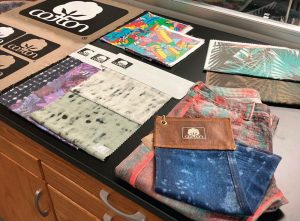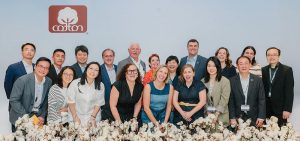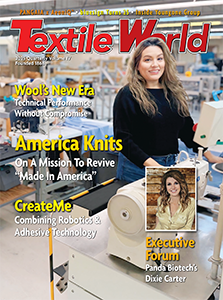
Cotton Incorporated’s new President and CEO William Kimbrell intends to reinforce the organization’s role as a trusted partner and respected industry leader.
TW Special Report
Cary, N.C.-based Cotton Incorporated is a research and promotion not-for-profit charged with the mission to increase the demand for and profitability of cotton.The company — funded by U.S. growers of upland cotton and importers of cotton textile products — was founded in 1970 in response to the rise of synthetic textile fibers and their impact on cotton’s market share.
Recently, the organization announced the promotion of William Kimbrell to president and CEO. Kimbrell has been at Cotton Incorporated for 22 years holding a variety of positions. He has experience in fiber processing research, as well as roles in the Global Supply Chain Marketing division including technology management, and marketing initiatives with a concentration on Asia. Prior to the promotion, Kimbrell was executive vice president and COO.
Kimbrell graduated from NC State’s Wilson College of Textiles with a degree in Textile Management. He also holds an MBA with a concentration in Supply Chain Management.
At the time of his appointment, Marvin Beyer, chairman of Cotton Incorporated’s Board of Directors, said: “William’s technical expertise along with his extensive global supply chain marketing background provides a deep understanding of the challenges and opportunities facing the cotton industry today. Under his guidance, Cotton Incorporated is well-positioned to continue driving innovation and promoting the many benefits of cotton, making it the fiber of choice in the global textile industry.”
Kimbrell certainly brings a sharp perspective to his new role at Cotton Incorporated. Textile World recently sat down with him to discuss the future of cotton and his leadership style, as well as topics impacting the global cotton supply chain including sustainability, research and trade.
TW: How do your 22 years at Cotton Incorporated and strong technical back-ground influence your approach to guiding and leading the organization into its next chapter?
Kimbrell: My 22 years with the company have been incredibly rewarding. I have had the opportunity to work in so many aspects of the organization from fiber and research to marketing initiatives. It has really provided me with an end-to-end understanding of how Cotton Incorporated supports and drives the cotton and textile industry from fiber to finished product. This experience has equipped me to be both strategic and responsive to a market that is constantly evolving. More importantly, it has reinforced my belief in the critical role Cotton Incorporated plays as a trusted source of science, data, and market insight — helping ensure cotton remains the preferred fiber in a competitive market.
TW: What have been your top priorities during your first few months as CEO and is there anything that surprised you about the transition?
Kimbrell: As you are aware, the cotton and textile industry are facing challenging times across the entire supply chain — from farm to retail to consumer. My top priority has been to take a hard look at our program strategy and ensure we’re making the most of our resources — aligning every effort to directly support the industry’s core needs while positioning cotton for long-term growth.
One of my key priorities is to build on the strong foundation we’ve established, while recognizing rapidly changing market dynamics require fresh thinking and new strategies. Cotton Incorporated has consistently delivered meaningful research across both the agricultural and textile sectors. We’ve implemented effective marketing campaigns targeting both the supply chain and consumers. Our Seal of Cotton, has more than 50 years of history and substantial brand equity — demonstrating trust and quality while reinforcing our industry’s dedication to excellence and innovation. Looking ahead, I’m focused on advancing this legacy through a new generation of initiatives that strengthen cotton’s position.
As for the transition itself, I’ve been around for a while, so no real surprises. I feel privileged to be stepping into this role at a time when there are such important opportunities ahead. I’m focused on working alongside our incredible team of experts to tackle these challenges head-on.
TW: What is your strategic vision for Cotton Incorporated over the next five years and how does it capitalize on cotton’s storied past?
Kimbrell: At Cotton Incorporated, we often talk about cotton as the preferred fiber, but my vision is to ensure that cotton is the fiber of choice.The fiber of choice at every stage of the supply chain, from the farm to brands and the consumer. Over the next five years, my strategic focus is to strengthen cotton’s position by elevating cotton as a natural fiber that delivers solutions. Solutions from product innovation to sustainability, performance, and compliance — all while driving economic viability for U.S. producers.
This strategy will be rooted in innovation from advancing farming practices and fiber development to expanding end-use applications. We will work to grow cotton’s presence in emerging markets and new product categories, reinforcing its role as a versatile, high-quality material that meets evolving demands. While we honor cotton’s rich heritage, we’re focused on securing its future — making sure it remains the fiber of choice for generations to come.

Research & Development
TW: Cotton Incorporated is known for research and development initiatives throughout the cotton supply chain beginning in the field and ending with cotton products. Any new or interesting initiatives underway?
Kimbrell: Yes, we are continuously advancing research and development initiatives to enhance cotton’s performance, sustainability and market opportunities. A key focus is advancing cotton’s role in circularity, exploring innovative solutions like our cotton to sugar initiative, transforming textile cotton waste into glucose, and other end-of-life solutions like composting, and upcycling. These initiatives aim to further solidify cotton’s position as a renewable resource.
We are also committed to developing performance technologies that do not compromise cotton’s inherent advantages, ensuring that cotton continues to meet the evolving needs of brands and consumers. The most recent technology we released was RESTech Cotton™. Cotton is often the natural choice for bedding because of its soft, breathable qualities. RESTech Cotton builds on those properties adding exceptional smoothness, quicker dry time, and greater abrasion resistance. More information on this finish and our suite of performance cotton technologies is available on our CottonWorks™ website.
CottonWorks also hosts a robust collection of digital fabric developments. We release new collections of knit and woven fabrics twice a year and these developments are a tremendous resource to the industry.
Beyond product, we’re exploring new applications for cottonseed oil and biochar, expanding their use in industries such as food, energy, and soil health. These efforts are aligned with our broader sustainability goals and highlight the versatility of cotton as a natural resource. Lastly, we are extending the impact of our Blue Jeans Go Green™ program, which promotes the recycling of denim into new products, further contributing to the circular economy and reducing waste in the textile industry.
TW: Are there areas of seed, agriculture, fiber, yarn, or fabric innovation that are most critical for the cotton industry over the next three to five years?
Kimbrell: Over the next three to five years, key innovations will be important for the cotton industry, particularly in agriculture, fiber, and across the supply chain.
On the agricultural side, advancements will focus on improving soil health, increasing water efficiency, and enhancing carbon sequestration, all of which contribute to producer profitability and the sustain-ability of cotton farming.
Additionally, automation and emerging technologies, such as “see and spray” systems, will play a significant role in optimizing cotton production. These technologies will help improve precision in farming, optimize input use efficiency, and further enhance cotton’s sustainability credentials.
Across the entire supply chain, it is essential that cot-ton meets and exceeds the performance, environmental, and compliance needs of brands and retailers and be positioned as a solution.
TW: Are there any emerging technologies or innovations that you believe have the potential to significantly transform the use of cotton in the textile industry over the next decade?
Kimbrell: The next decade holds great promise for cotton, with innovations in fiber quality and consistency, and performance-enhancing finishes, especially those derived from biobased materials, opening the door to new products. At the same time, low-impact processes are making more efficient use of water, energy and chemistry which supports environmental goals and efficiencies. Advances in circularity, including upcycling and the exploration of new markets, will further solidify cotton’s role as a key sustainable material in the textile industry.

Incorporated
experiments with a
variety of dyeing techniques including digital printing.
Cotton Marketing
TW: Cotton Incorporated was founded 55 years ago in response to the rise of synthetic fibers and their impact on cotton’s market share. How has the fiber landscape changed over the years and how do you see Cotton Incorporated’s role in today’s altered fiber marketplace?
Kimbrell: When Cotton Incorporated was founded in 1970, synthetic fibers like polyester were rapidly gaining ground, largely due to their low cost and ease of care. Cotton faced an urgent need to innovate, to promote its natural strengths, and to reclaim its relevance with consumers and manufacturers. Over the decades, the fiber marketplace has continued to evolve. Today, competition in the fiber market is even stronger and innovation cycles are faster and more complex than ever before.
However, the market needs have shifted. While product performance remains a key priority, today’s consumers and brands place increasing importance on compliance issues like sustainability, traceability, and circularity — areas where cotton has a tremendous opportunity to be the solution. Cotton Incorporated’s role remains critical in ensuring that cotton continues to lead as a high-quality, versatile, and compliant fiber. Through science-based research and innovation, our mission to protect and grow demand for cotton remains the same, but our approach has broadened in how we meet that mission.
TW: U.S. cotton has global opportunities. What is Cotton Incorporated’s approach to support demand around the globe?
Kimbrell: We support global demand for U.S. cotton by leveraging our unique expertise in technical research, innovation, marketing and supply chain support. There is simply no other organization or facility like Cotton Incorporated. Our people and their subject matter expertise help ensure U.S. cotton continues to meet the diverse needs of the global market. As the top resource for cotton, we collaborate closely with stakeholders across the value chain, ensuring U.S. cotton remains competitive in the global market.
TW: Cotton has long been “The Fabric of Our Lives.”Will we see any shifts in Cotton Incorporated’s branding or messaging under your leadership?
Kimbrell: The iconic “The Fabric of Our Lives” campaign continues to be a cornerstone of our consumer brand strategy.The iconic campaign has evolved to meet the needs of today’s consumers, targeting 18-34 year-old, primarily female, Gen Z and Millennials. A recent shift to the “Fabric of Now”campaign takes a more modern marketing approach employing social media, influencers and strategic brand partnerships shifting the focus to targeted consumer engagement around cotton’s key benefits through education and driving behavior change.
TW: Cotton Incorporated has long focused on market research and data collection to support its research and marketing efforts. What opportunity does artificial intelligence present in this data management and analysis?
Kimbrell: With research at our core, we’ve always embraced technology, and artificial intelligence offers tremendous benefits. That said, we will continue to rely on our subject matter experts and key stakeholders to ensure the data and insights are grounded in industry knowledge and practical experience. Combining AI with expert-driven insights allows us to refine our strategies, predict market trends and optimize supply chain management while we ensure our research, and marketing efforts remain at the forefront of the cotton industry.

Supply Chain
TW: The push for transparency and traceability is increasing in the textile industry. How does Cotton Incorporated support the cotton industry moving towards a more accountable supply chain?
Kimbrell: The push for greater transparency and traceability in the textile industry is accelerating, and Cotton Incorporated is committed to being a trusted resource for manufacturers, brands, and retailers navigating this evolving landscape. We actively support the industry’s shift toward a more accountable supply chain by providing objective guidance on traceability technologies and sourcing strategies.Through our CottonWorks platform, we offer extensive sourcing support, technical insights, and educational resources to help partners make informed decisions that align with their traceability goals.
Trade
TW: What are your thoughts on the implementation of tariffs and how they may impact U.S. cotton producers, as well as the international cotton supply chain?
Kimbrell: The rapidly evolving changes proposed around tariffs create uncertainty around purchasing decisions throughout the supply chain. Given the global nature of the textile supply chain, changes in tariff structures have the potential to increase costs and purchasing decisions at each stage of the supply chain, from fiber to finished good.
This uncertainty can dampen demand, independent of the direct impact of the eventual policies that are implemented over the longer-term.
The recent changes in tariffs are added onto existing rates. As a result, any existing tariff advantages cotton-dominant products have relative to man-made dominant products are maintained and should continue to support cotton’s share of U.S. imports.
TW: Do you see any other economic challenges for U.S. cotton producers and domestic cotton textile manufacturers?
Kimbrell: U.S. cotton producers and domestic cotton textile manufacturers are currently facing several economic challenges, including low prices, inflation, rising interest rates, and increasing input costs, all of which impact the economic viability of production. These challenges validate the importance of our research and the role of industry partnerships in navigating these conditions.
Cotton Incorporated is committed to supporting stakeholders, with a global presence of research and marketing experts positioned strategically to address these issues and help sustain the industry’s growth.
Sustainability
TW: What’s your assessment of the sustain-ability narrative surrounding cotton, and how are you calibrating messaging and research to ensure data-driven advocacy?
Kimbrell: The sustainability narrative surrounding cotton is strong. As a natural fiber, cotton has a clear advantage in this space, with its natural biodegradability and microplastic-free benefit. Cotton is grown from the earth and can be returned to the earth. Our story is compelling, backed by data-driven research that highlights cotton’s sustainability benefits. This positions cotton as the natural, eco-friendly choice in the fiber market, reinforcing its unique place throughout the supply chain.
TW: How do you see consumer awareness and behavior influencing the adoption of sustainable practices? What role does consumer education play in driving demand for truly sustainable products?
Kimbrell: Consumer awareness and behavior are key drivers in the adoption of sustainable practices. Our 2025 Lifestyle Monitor™ Survey found that the majority of consumers — 71 percent — say they are likely to check the fiber content label before purchasing a clothing item to avoid apparel made from synthetic fibers. As consumers become more conscious of environmental impacts, particularly with the increased visibility of the threat of microplastics, their preference for natural, biodegradable materials will increase.
Education plays a vital role in shaping these behaviors and it is essential for brands and retailers to provide greater visibility and transparency about the fibers they use, making it easy for consumers to find and choose truly sustainable products.

Concluding Thoughts
TW: Are there any factors that concern you with regards to successfully maintaining and growing cotton’s future?
Kimbrell: We are navigating through undeniably complex times. From the field to the consumer, challenges are weighing heavy on the cotton industry. Our growers are under immense pressure. Rising input costs, depressed prices, and unpredictable yields have created a tough environment where profitability is hard-won.
On the product side, we continue to confront a fiber market that is evolving rapidly. It is a fiber market where low-cost synthetics have gained market share. However, these short-term advantages come with long-term environmental costs like microplastics. It’s a firm reminder that innovation, performance, and leaning into cotton’s natural advantages are critically important. Cotton is a versatile, high-quality, safe and compliant fiber so even in the midst of these headwinds, this environment is full of opportunity.
At Cotton Incorporated, we are not new to adversity. The Cotton Research and Promotion Program was built to address exactly these kinds of challenges and market complexities. Whether it’s advancing cutting-edge agricultural research, driving sustain-ability initiatives, or developing technologies that help cotton compete on efficiency and performance, our work is laying the foundation for a more competitive and sustainable future for cotton. Our marketing efforts continue to build trust and relevance for cotton with our “customers” — manufacturers, brands, retailers and consumers around the world. These efforts don’t just promote a fiber — they promote a story of stewardship, innovation and authenticity that sets cotton apart.
Undoubtedly, there is more work to be done. The challenges we face are not short-term. We must keep pace with accelerating innovation in alternative fibers. We also must remain vigilant in communicating cotton’s strong environmental story in a world where regulatory pressures, misinformation, and shifting consumer expectations abound. Finally, sustaining cotton’s future means standing firmly behind our growers — through strategic investment in research, technology, and advocacy that reinforces cotton’s economic viability. I’m confident in the talent and dedication of the Cotton Incorporated team and the strength of our stakeholder community. With the right focus and collective will, we have the capability to deliver meaningful progress and move cotton forward in a rapidly changing world.
TW: When you look back on your tenure, what do you hope to have achieved both for the cotton industry and the organization?
Kimbrell: Cotton is truly the “Fabric of our Lives.” It touches nearly every part of our daily routines — offering comfort, durability and versatility in a way that only a natural fiber can. But cotton is more than a product; it’s a cornerstone of the global economy, sustaining the livelihoods of millions of farmers and workers. Grown in 77 countries, traded across more than 80 countries, and used in manufacturing in nearly 160 countries, cotton is a truly global fiber of great significance.
At Cotton Incorporated, the work we do matters — to all of these stakeholders. It matters to farmers whose livelihoods depend on a healthy, vibrant textile industry. It matters to families who rely on cotton products every day. It matters to manufacturers, brands, and retailers looking for sustainable, high-quality materials. And it matters to the future of an industry that is interwoven with the economies and communities around the world.
When I look back on my tenure, I hope it will be defined by measurable, meaningful progress — progress that strengthened cotton’s position in the market, enhanced Cotton Incorporated’s ability to support the industry, and added real value for all cotton stakeholders. I want us to have expanded cotton’s relevance not just through innovation in the field, fiber and fabric, but through marketing that authentically tells cotton’s story — a story rooted in stewardship, quality and enduring value.
I also hope to have led Cotton Incorporated in a way that reinforced its role as a trusted partner and respected industry leader — a source of expertise, collaboration, and inspiration from farm to retail. Ultimately, our success will be measured by more than market share. It will be seen in the strength, resilience, and continued relevance of cotton as the fiber of choice for generations to come.
2025 Quarterly Issue II




